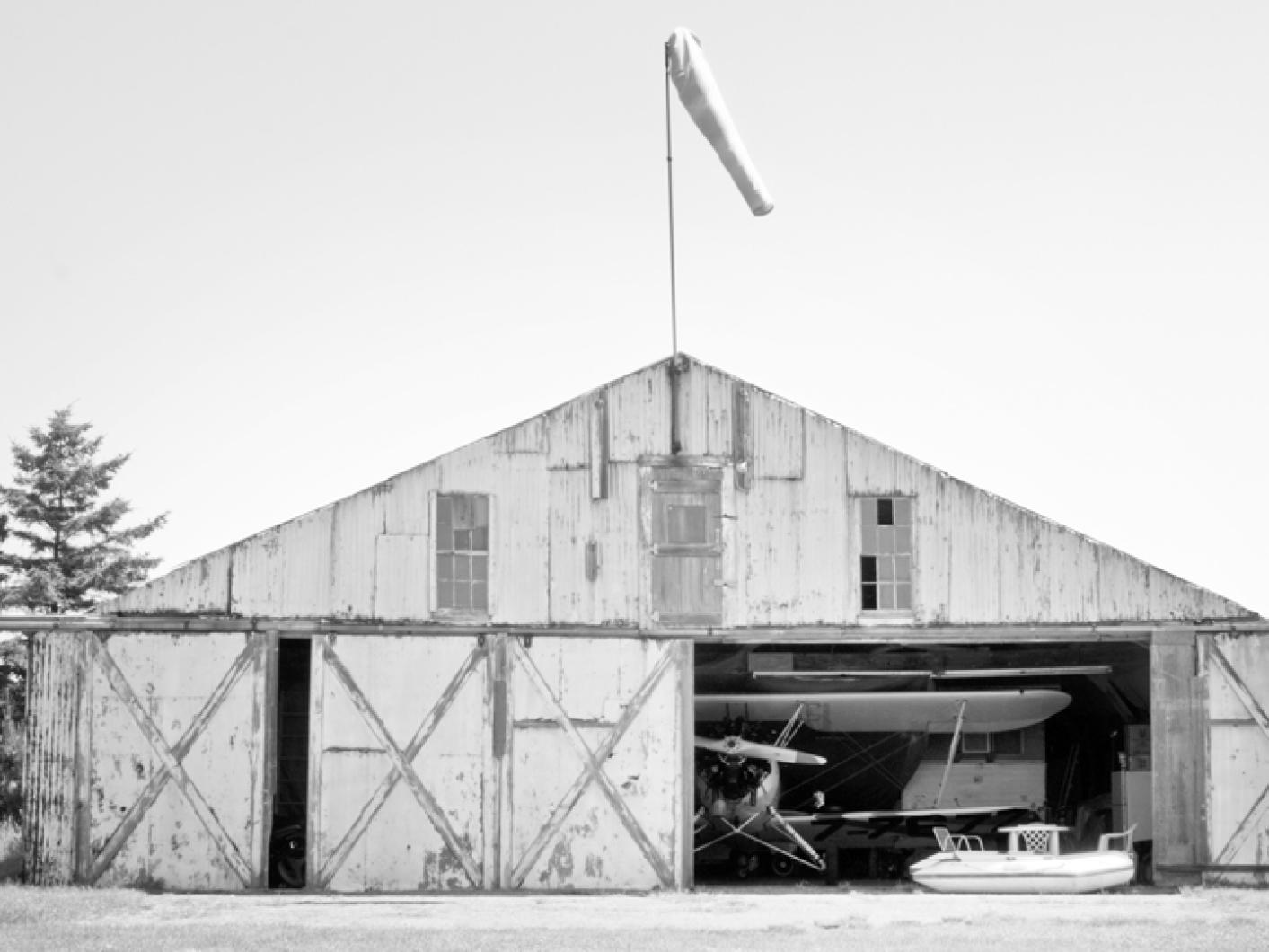In the fall of 1944, a hurricane swept through the Vineyard, hitting Katama and damaging beyond repair the two hangars used to service Katama Airfield. Out of scraps collected from the two destroyed structures, a group of Islanders fashioned a new hangar in 1945 to help get the tiny airpark up and running again. Almost as soon as it went up, the new structure was outdated, requiring renovation and repair to meet the needs of the airfield aviation team.
Now 65 years later, that same building still stands, looking as though it couldn’t put up much of a fight against an angry northeaster. In fact, the sagging structure, nestled just behind the airfield’s Right Fork Diner, off a dusty dirt road, looks as if it might buckle under the weight of a swift gust of wind. Vines crawl from underneath the foundation up to the hangar’s roof, which is tinted red with the particles of rust that appear to be holding it together.
It was recently described by the Edgartown conservation commission as “woefully inadequate.” Airport manager Mike Creato said yesterday that the hangar, though rich with history, has become essentially unusable for anything more than the most minimal storage. If that.
“The size of the existing hangar was dictated by the scrap that was left by the two hangars that blew down in the hurricane of [1944],” he said. “My grandfather and his pals built whatever hangar they could out of the remnants, because, it’s hard to imagine, but there were no materials available after World War II. You used what you had. They built it with straightened-out nails and scrap that they were able to pick up around Katama. It wasn’t built in a logical size, and it’s pretty challenged. The door height, for instance, doesn’t accommodate, I would say, 90 per cent of the airplanes that use the field today.”
The solution seems simple enough: Rebuild the hangar to meet the needs of the airpark. After more than half a century, the renovation project could hardly be considered premature.
But in the mid-1980s, Edgartown entered a partnership with the state and the Nature Conservancy, purchasing the airfield and more than 100 surrounding acres of land, which harbor many rare plant and animal species. The land was placed under a conservation restriction, which, among other things, prohibits any footprint expansion of existing buildings.
Hoping to replace the dilapidated hangar with a slightly larger, more usable structure, Edgartown voters approved an article at the April annual town meeting to revise the conditions of the conservation restriction. Money for the work has been set aside in the town Community Preservation Act fund. But changing a conservation restriction requires approval at the state level, and in a letter last month from the Division of Conservation Services to the town conservation commission, the state rejected the request.
Which leaves Edgartown officials, and frequent airfield users, in search of an alternate plan.
Mr. Creato said town officials might not have acted so hastily on approving the conditions of the conservation restriction back in the 1980s, had they known the difficulty they would face in updating the hangar. “In hindsight, I don’t know that the town would have signed off on [the conditions]. But I think at the time, everybody was so happy that this land was going to be saved. that they did,” he said.
He said there are two main reasons that the expansion is necessary — and urgent. One is that the use of the diner has expanded, and is currently competing for space with the hangar. “They’ve got this big green thing out here . . . which has refrigeration equipment in it. That was to be a temporary measure until the hangar got built. And here it is 10 years later, it’s still out here, and nobody can see any way to get rid of the thing and still operate the restaurant successfully,” Mr. Creato said.
Even more pressing is the fact that the existing hangar is dilapidated beyond repair and essentially useless for the storage of most airplanes. And while the new unit would increase the size of the hangar footprint by some 2,000 square feet, it would also greatly increase the efficiency of the airport. “It might accommodate, if you properly stack them for a storm, five or six airplanes,” said Mr. Creato. “It would be a usable door height, etc. We could put the office out there. It would just allow the aviation side of this recipe to work. We’ve struggled for a long time with a one-airplane hangar.”
He said the town, the Nature Conservancy and the Massachusetts Wildlife Natural Heritage and Endangered Species Program, another office associated with the preservation of the airpark and surrounding land, are all in agreement that the conservation restriction could be changed without compromising the environmental integrity of the fragile area. “I think the part that’s important to remember is the reason that this field is here is because people loved airplanes and the town wanted to preserve it. And it’s great that it is satisfying the nature people and the airplane people. But if the airplanes go away, I think the town’s interest in this place would be a little bit diminished also,” Mr. Creato said.
“We’re just looking for a place to be able to operate; to be able to work on airplanes indoors; to be able to safely store a few airplanes, especially in the winter. And to clean the mess up that’s on the outside of this building. It seems like a reasonable request to us.”




Comments (1)
Comments
Comment policy »